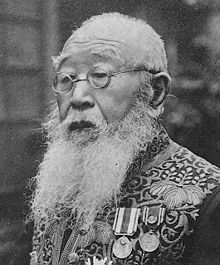Takamura Koun
Takamura Kōun ( Japanese 高 村 光 雲 , real name: Nakajima Mitsuzō ( 中 島 光 九 蔵 ); born March 8, 1852 in the Shitaya district (today: Taitō ) in Edo ; died October 10, 1934 in Tokyo ) was a Japanese sculptor. The poet and sculptor Takamura Kōtarō and the metal caster Takamura Toyochika were his sons; the photographer Takamura Tadashi, who died in 2014, was his grandson.
Life
Takamura was a student of the sculptor Takamura Tōun ( 高 村東 雲 ). When he was later taken into the household of Tōun's older sister, he took the surname Takamura. And when he was allowed to take over the second character of the first name of his teacher, he chose the stage name "Kōun". At the first “National Industrial Exhibition” (内 国 勧 業 博 覧 会, Kokunai kangyō hakurankai) in 1877, his sculpture entitled “White-clad Kannon” (白衣 観 音), which he had submitted under the name of his master, was awarded the highest prize, the “ Dragon Seal Prize “(竜 紋章, Ryūmonshō).
Takamura carefully and diligently made sculptures in the traditional way, but he also showed great interest in the realistic representation of Europe. In this way he contributed to the revitalization of Japanese sculpture, which at the time had sunk into a formal mode of representation. His masterpiece, the "Old Monkey" ( 老 猿 ), which he completed in 1892 and which was shown at the World's Fair in Chicago the following year , proves his skills.
In 1887 Ernest Fenollosa and Okakura Tenshin brought him to the Tōkyō Bijutsu Gakkō ( 東京 美術 学校 ), the forerunner of today's Geidai , where he taught until 1926 as head of the sculpture department . His bronze statue of Saigō Takamori , completed in 1898, stands high above the entrance to Ueno Park in Tokyo. In 1925 he participated with the work Protection by the mountain spirits ( 山 霊 訶 護, Sanreikago ) in the Exposition Internationale des Arts Décoratifs et industriels modern in Paris.
Takamura was appointed an artist at court (Teishitsu gigei-in). He acted as a juror at the art exhibition organized annually by the Ministry of Culture since 1907 (文部省 美術展 覧 会, Mombushō bijutsu tenrankai), became a member of the Japanese Academy of Arts and a member of the committee for the preservation of national works of art . - He is buried in Somei Cemetery in the Toshima district of Tokyo.
His students include the sculptors Yamamoto Zuiun (山 本 瑞雲; 1867–1941), Yamazaki Chōun (1867–1954), Yonehara Unkai (米 原 雲海; 1869–1925) and Hirakushi Denchū (1872–1979).
Individual evidence
- ↑ 高 村 光 雲 . In: デ ジ タ ル 版 日本人 名 大 辞典 + Plus at kotobank.jp. Retrieved January 1, 2017 (Japanese).
- ↑ An important cultural asset of Japan , today in the Tokyo National Museum
literature
- Tazawa, Yutaka: Takamura Kōun . In: Biographical Dictionary of Japanese Art. Kodansha International, 1981. ISBN 0-87011-488-3 .
Web links
- Encyclopedia Britannica - Takamura Kōun
- Japanease celebrity's grave guide - Koun Takamura (1852-1934)
- Find a Grave - Koun Takamura
| personal data | |
|---|---|
| SURNAME | Takamura, Koun |
| ALTERNATIVE NAMES | 高 村 光 雲 (Japanese); Nakajima Kōzō (real name); 中 島 幸 吉 (real name, Japanese) |
| BRIEF DESCRIPTION | Japanese sculptor |
| DATE OF BIRTH | March 8, 1852 |
| PLACE OF BIRTH | Shitaya today: Taitō , Edo |
| DATE OF DEATH | October 10, 1934 |
| Place of death | Tokyo |

